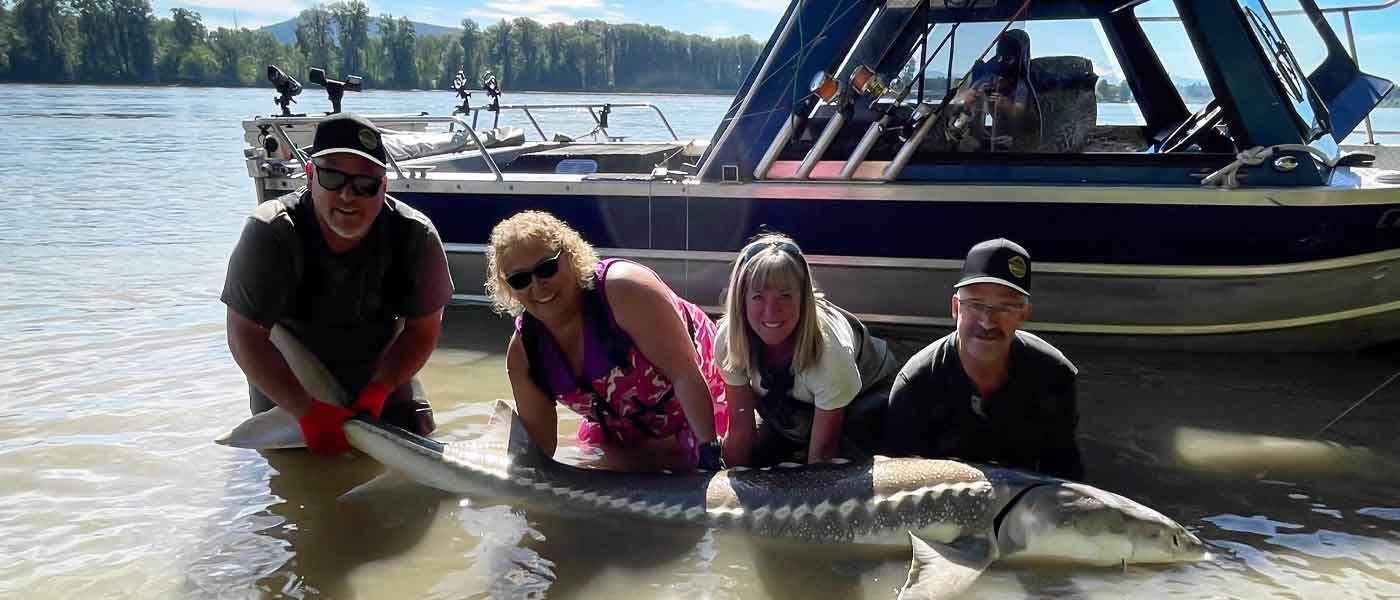Golden Ears Fishing Adventures
7 Safety Tips for Ensuring a Safe and Enjoyable Fishing Experience in the Summer Heat
Safety Tips for Anglers: Ensuring a Safe and Enjoyable Fishing Experience in the Summer Heat
Summer is the perfect time for fishing enthusiasts to hit the waters and enjoy the thrill of the catch. However, the heat and sun can pose significant risks if not properly managed. To ensure a safe and enjoyable experience, it’s essential to be prepared and take necessary precautions. This guide provides detailed safety tips for anglers, focusing on hydration, sun protection, appropriate clothing, recognizing heat-related illnesses, staying informed about weather conditions, carrying essential gear, and practicing responsible fishing.
Stay safe, comfortable, and responsible while making the most of your summer fishing adventures out on the Fraser River.
1. Stay Hydrated
Staying hydrated is crucial, especially during summer fishing trips. When you’re out in the sun for extended periods, your body loses water through sweat, which can lead to dehydration if not replenished. Start your day with plenty of water and continue drinking small amounts regularly, even if you don’t feel thirsty. Aim for at least eight glasses of water a day, but increase this amount if you’re sweating heavily. We provide complimentary drinks on board.
Carry a large, insulated water bottle to keep your water cool. Consider adding electrolyte tablets or drinks to your hydration routine, as they can help replace lost salts and minerals, preventing conditions like heat exhaustion or heat stroke. Avoid caffeinated drinks and alcohol as they can dehydrate you further.
Ensure you have an ample supply of fresh water. Make hydration breaks a part of your routine; set reminders if necessary. Additionally, snack on water-rich foods like fruits and vegetables. Staying hydrated keeps your energy levels stable, ensuring you stay focused and enjoy your fishing experience.
2. Protect Yourself from the Sun
Sun protection is vital to prevent sunburn and reduce the risk of skin cancer. Apply a broad-spectrum sunscreen with at least SPF 30 to all exposed skin 15-30 minutes before going outside. Reapply every two hours, or more frequently if you’re sweating or have been in the water. Don’t forget areas like the back of your neck, ears, and the tops of your feet.
Another safety tip is to wear protective clothing, such as long-sleeved shirts, long pants, and a wide-brimmed hat. Clothing made from lightweight, breathable, and UV-protective fabrics can keep you cool while protecting your skin. Sunglasses with UV protection are essential to shield your eyes from harmful rays, reducing the risk of cataracts and other eye issues.
Taking breaks in shaded areas, such as under our boat canopy, can help you stay cool and protect your skin from continuous sun exposure. Remember, the sun’s rays are strongest between 10 AM and 4 PM, so try to minimize direct sun exposure during these hours. These measures will help you stay safe and comfortable during your summer fishing adventures.
3. Dress Appropriately
Choosing the right clothing can make a significant difference in your comfort and safety while fishing in the summer heat. Opt for light-colored, loose-fitting clothing made from breathable fabrics like cotton or moisture-wicking materials. These fabrics help keep you cool by allowing sweat to evaporate more easily.
Moisture-wicking fabrics, in particular, pull sweat away from your skin and allow it to evaporate quickly, keeping you dry and comfortable. Look for clothing with built-in UV protection to add an extra layer of defense against the sun’s harmful rays.
Layering can also be beneficial. Start with a moisture-wicking base layer, add a lightweight, long-sleeved shirt, and finish with a wide-brimmed hat to protect your face and neck. Don’t forget to wear a buff or neck gaiter to protect the back of your neck and face.
Footwear is another important consideration. Wear lightweight, breathable shoes or sandals that provide good grip and support, especially if you’re fishing from a boat or rocky shore. Consider water shoes if you’ll be wading in shallow areas. Dressing appropriately not only enhances your comfort but also helps prevent heat-related illnesses.
4. Watch for Heat Exhaustion
Heat exhaustion is a serious condition that can occur when your body overheats. Symptoms include heavy sweating, weakness, dizziness, nausea, headache, and muscle cramps. If you experience any of these symptoms, it’s crucial to act quickly to cool down.
Find a shaded or air-conditioned area to rest. Drink cool water or an electrolyte-replenishing drink slowly, and avoid caffeine and alcohol. Apply cool, wet cloths to your skin or take a cool shower or bath if possible. Loosen tight clothing and remove any unnecessary layers to help your body cool down.
It’s important to recognize the signs of heat exhaustion early and take immediate action. If left untreated, heat exhaustion can progress to heat stroke, a life-threatening condition. Prevent heat exhaustion by staying hydrated, taking frequent breaks in the shade, and wearing appropriate clothing.
Plan your fishing trips for early morning or late afternoon when temperatures are cooler. Use a buddy system to keep an eye on each other for signs of heat exhaustion. By staying vigilant and taking preventative measures, you can ensure a safe and enjoyable fishing experience.
5. Stay Informed
Staying informed about the weather conditions before and during your fishing trip is crucial for your safety and is one of the more important safety tips we can suggest. Check the weather forecast for the day and be aware of any heat advisories, severe weather alerts, or sudden changes in weather conditions. Websites and apps can provide real-time updates and alerts.
Understanding the local climate and weather patterns can help you plan your trip more effectively. For example, knowing when thunderstorms are likely to develop in the afternoon can help you avoid being caught in dangerous conditions.
In addition to weather forecasts, pay attention to tide charts and river conditions if you’re fishing in tidal areas or rivers. Sudden changes in water levels can affect your safety and the behavior of the fish you’re targeting.
Equip yourself with a reliable weather radio or smartphone app that provides real-time updates. Set up alerts for severe weather conditions. By staying informed and prepared, you can make informed decisions about when and where to fish, ensuring a safer and more enjoyable experience.
6. Carry Essential Gear
Carrying the right gear can make a significant difference in your safety and comfort during a summer fishing trip. Pack a well-stocked first aid kit that includes bandages, antiseptics, pain relievers, and any personal medications. Having a first aid kit on hand allows you to address minor injuries and ailments quickly.
Bring an ample supply of water and high-energy snacks to keep your hydration and energy levels up throughout the day. A cooler with ice packs can keep your drinks and snacks fresh and provide a source of cool relief.
Consider bringing a portable fan or misting device to help you stay cool in extreme heat. Sun protection gear, including sunscreen, hats, and sunglasses, should always be part of your kit. A multi-tool or fishing knife can be invaluable for a variety of tasks, from cutting lines to preparing bait.
Don’t forget to pack extra clothing in case you get wet or need to change due to sweating. A lightweight, waterproof jacket can protect you from unexpected rain showers. By carrying essential gear, you can handle a variety of situations and stay comfortable and safe during your fishing trip.
7. Fish Responsibly
Responsible fishing practices are essential for the conservation of fish populations and the environment. In the summer heat, it’s important to handle fish with care to minimize stress and increase their chances of survival after release.
Use barbless hooks or crimp the barbs on your hooks to make it easier to release fish without causing unnecessary injury. Wet your hands before handling fish to protect their slime coat, which is vital for their health. Avoid touching the gills or eyes, and support the fish’s body properly.
Limit the time you spend handling fish out of the water. Use a landing net to minimize stress and keep the fish in the water as much as possible while removing the hook. If you plan to take a photo, have your camera ready in advance to minimize the time the fish is out of the water.
Follow local fishing regulations and guidelines, including catch limits and seasonal restrictions. Practice catch and release whenever possible, especially with larger, breeding-age fish. By fishing responsibly, you contribute to the sustainability of fish populations and ensure that future generations can enjoy the sport.
By following these comprehensive safety tips, anglers can ensure a safe, enjoyable, and responsible fishing experience during the summer heat.
LET’s go fishing
READY TO CATCH SOME STURGEON?!
Mission Statement
To provide a memorable, once in a lifetime fishing experience, while bringing appreciation and awareness to the mighty sturgeon.
FISHING DAYS
Let's Go Anytime!
Monday Through Sunday
Open 8am - 8pm
Contact Us
(604) 813-3569
Launch Site: Sylte Shipyard Ltd., - 20076 Wharf St., Maple Ridge, BC (parking is along the side of the street at Sylte Shipyard)


